So what makes Granada so special?
It’s an ancient city, rich in historic architecture. Each of its atmospheric neighborhoods has a unique, earthy character that adds to the city’s charm.
While Granada is famous for the grand Alhambra, there’s so much more to this city than this impressive Spanish landmark.
Granada is a city of many layers, offering a Moroccan souk, a massive cathedral, the vibrant sounds of flamenco music, cool neighborhoods, and, a highlight for many, free tapas.
In this guide you’ll find all the top attractions in Granada.
Top Attractions & Things To Do in Granada
1. The Alhambra & the Generalife Gardens
A UNESCO World Heritage Site since 1984, the Alhambra is the #1 attractions in Granada. It’s one of those rare sights that truly deserves to be called breathtaking.
As the last and greatest Moorish fortress in Andalusia, its grandeur is undeniable. The Alhambra enjoys a spectacular location atop Sabika Hill. From there, it offers panoramic views of Granada and the picturesque surrounding countryside.
You’ll find it hard to put your camera down, as every corner and view is more beautiful than the last.
The Alhambra’s story began in 889 A.D. as a modest fortress, built on the ruins of an ancient Roman site. Unlike Seville’s Royal Alcazar, which blends Moorish and Christian styles, the Alhambra was constructed by the Moors, exclusively for Moorish use.
By the 13th century, the Christian Reconquista was in full swing, and in 1492, Granada was finally conquered by King Ferdinand and Queen Isabella. Thankfully, they recognized the Alhambra’s value and incorporated it into a lavish royal palace complex rather than destroying it.
The Alhambra’s most notable features include the Alcazaba, the Charles V Palace, and the incredibly stunning Nasrid Palace, each offering a glimpse into its rich history and architectural splendor.
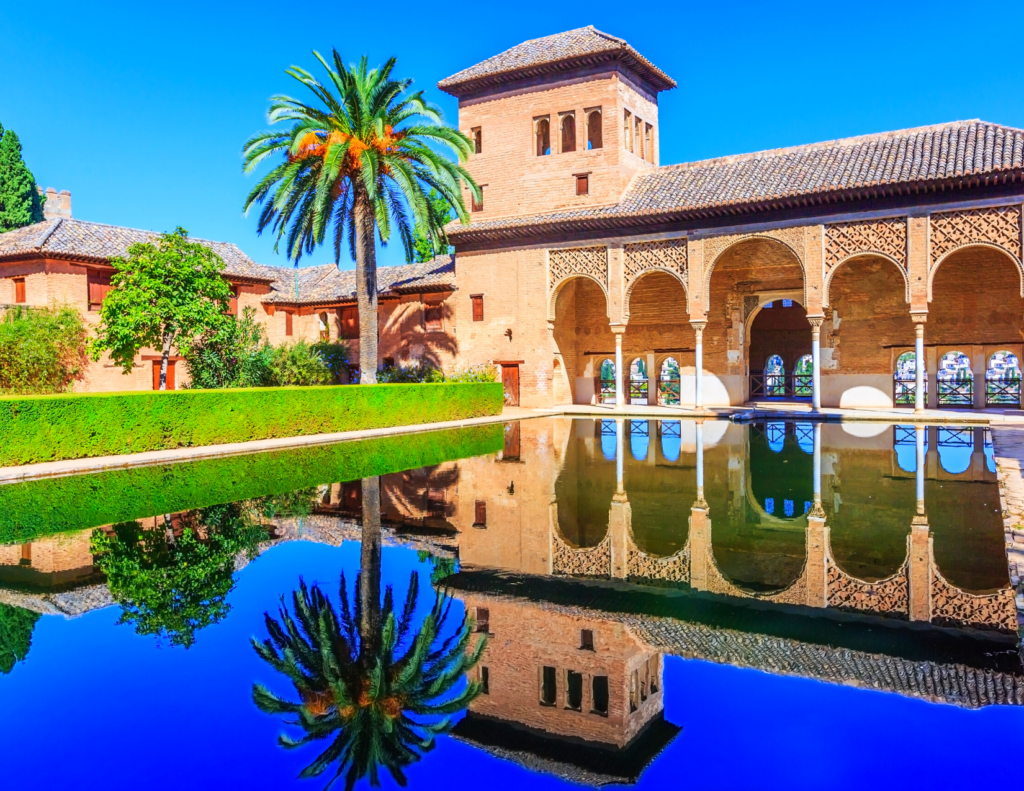
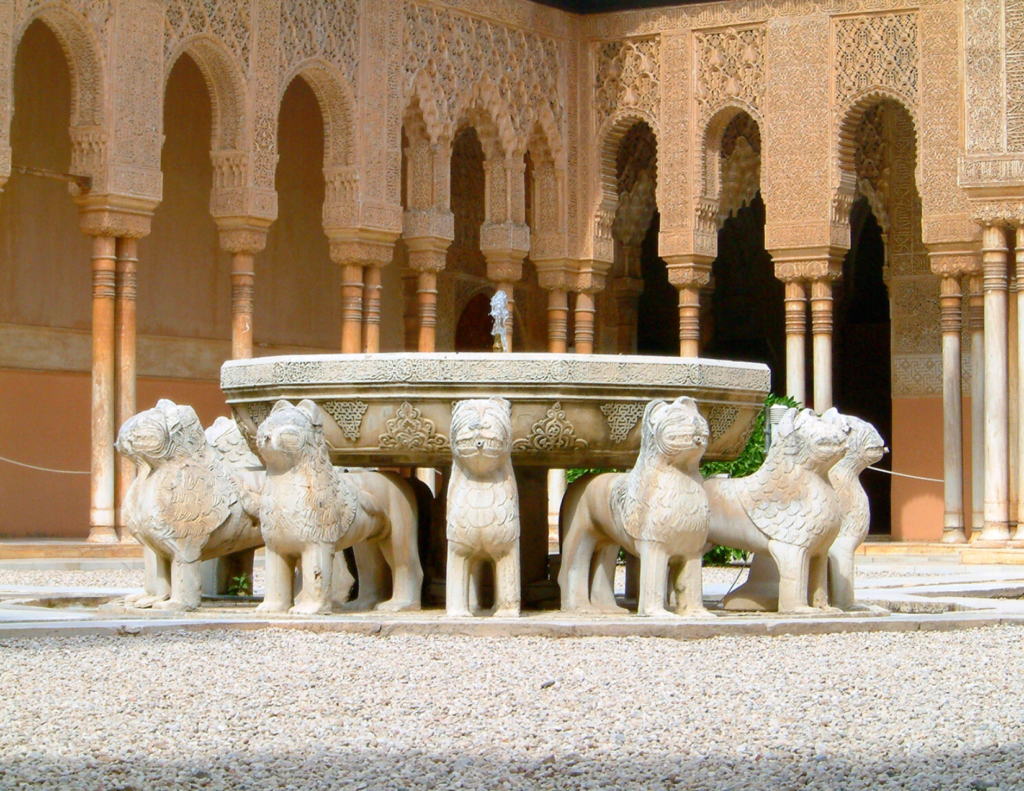
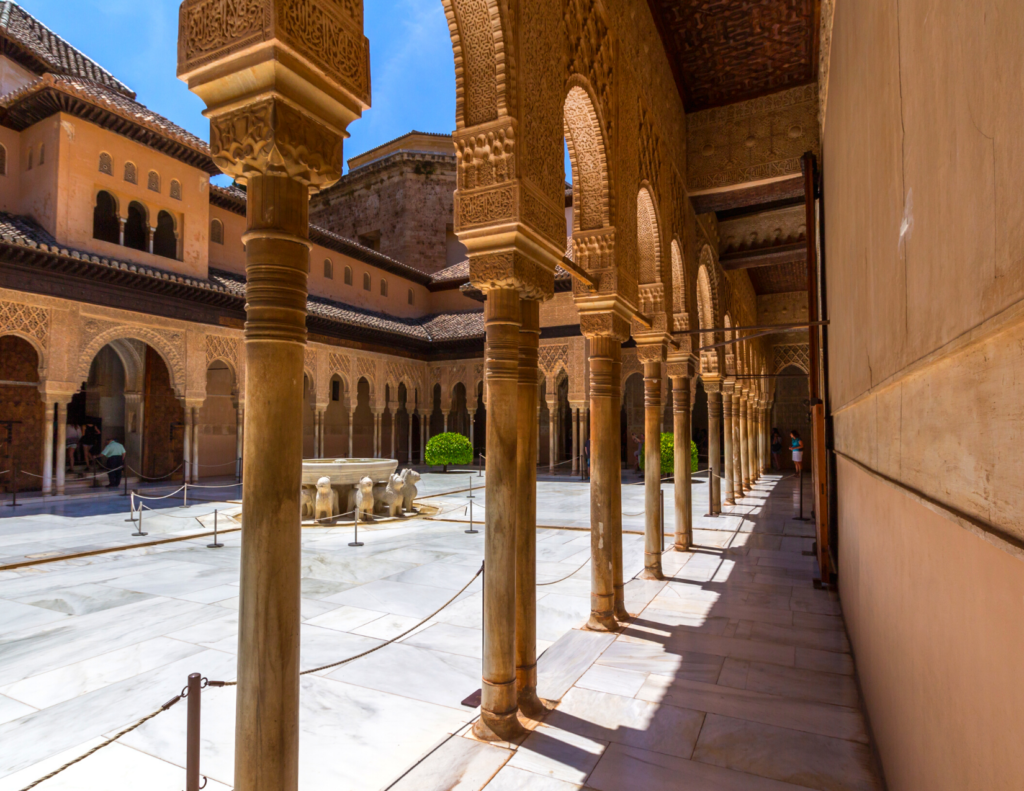
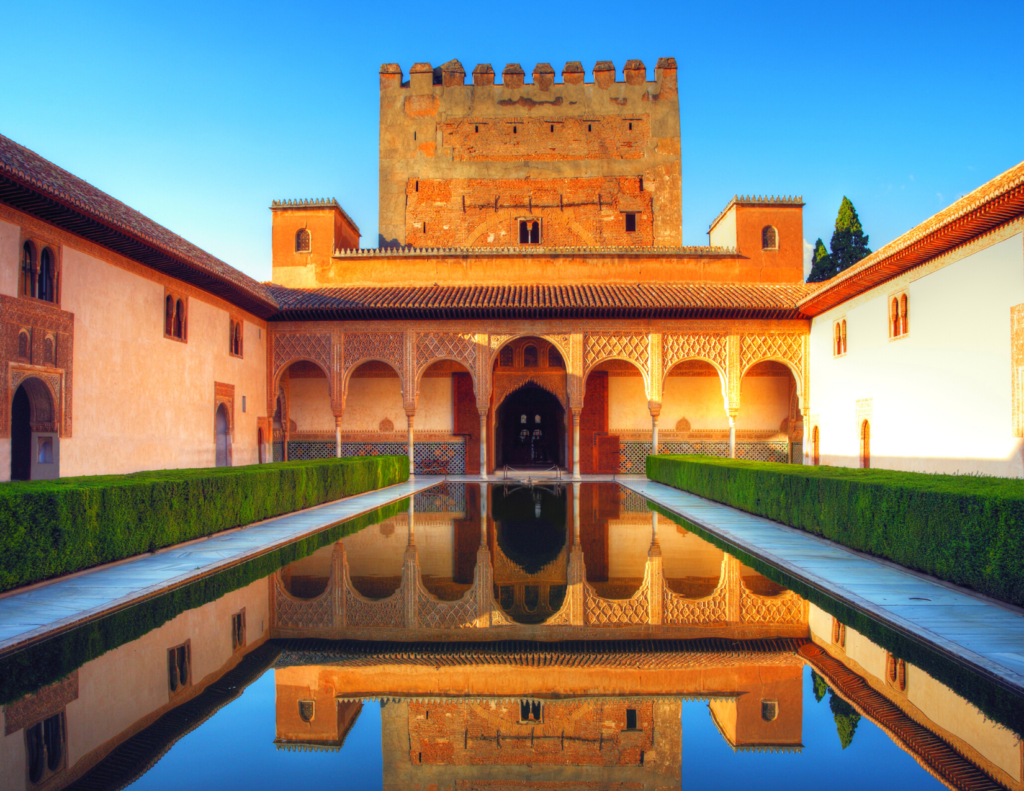
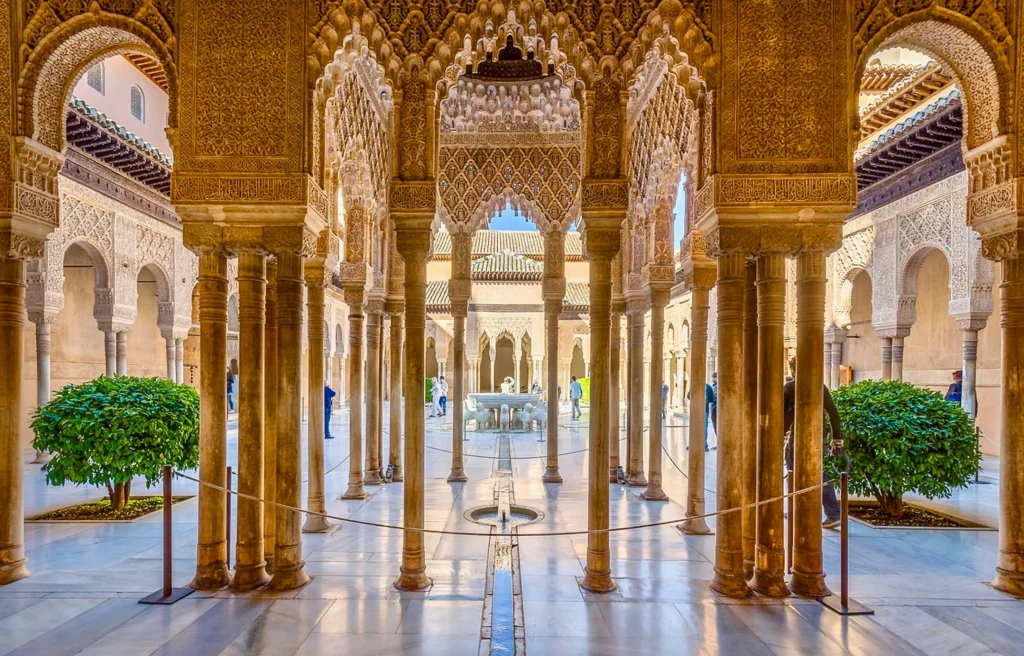
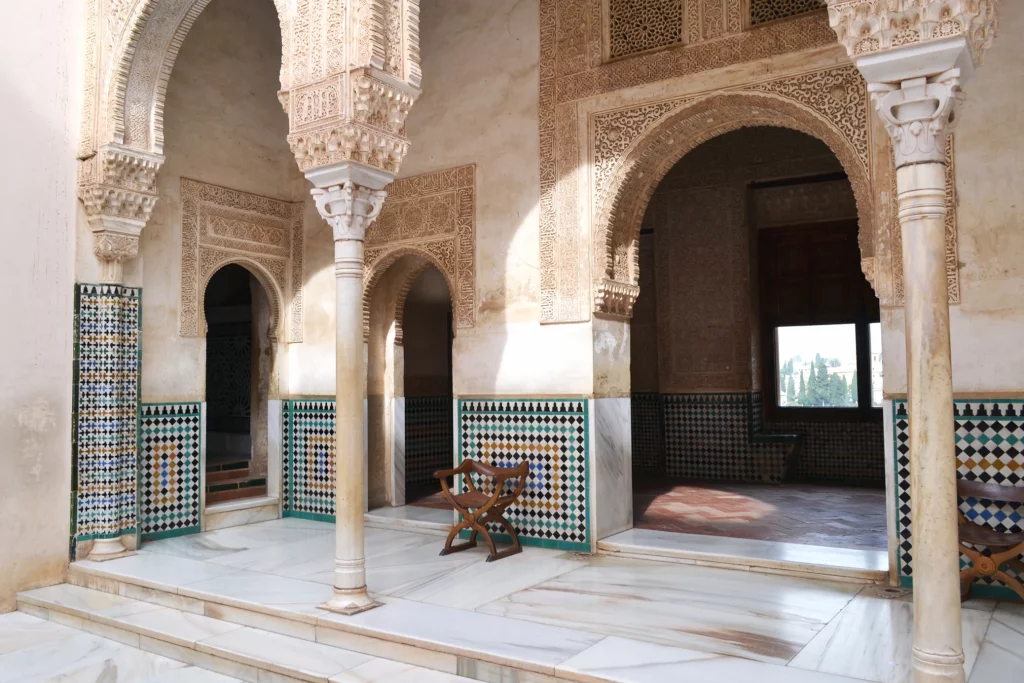
The Nasrid Palace is undoubtedly the crown jewel of the Alhambra. It offers the world’s finest vestige of the refined, intricate, and elegant architectural style of the Moorish civilization.
You’ll find room after room of intricate tile mosaics, delicate plaster reliefs, and elaborate coffered ceilings. The rooms are linked by gleaming patios with gurgling fountains and pools.
Highlights are the Courtyard of the Myrtles, the Throne Room, the Salon of the Abencerrajes, the Hall of the Two Sisters, and the Courtyard of the Lions (the most photographed spot).
When you’re done with the lavish palaces, head over to the Generalife Gardens. The gardens were the summer pleasure spot of the Nasrid rulers.
Generalife was the lush leisure villa of the last dynasty of Moorish sultans. They summered there to escape the intense heat. The theme is water.
In the Generalife Gardens, narrow paths run alongside flowerbeds. There are terraced gardens, reflecting pools, and fountains.
It really makes sense to book a tour of the Alhambra because it’s so extensive and so important.
Here are some of you ticket and tour options:
- skip the line ticket + audio guide
- private tour of the complex
- skip the line ticket + guided tour
- small group tour of the Alhambra and Albaicin neighborhood
- Alhambra tour from Seville
- VIP small group tour
2. Granada Cathedral
After staggering out of the Alhambra, slack jawed, stroll down the hill into Plaza Nueva. Cross the square and you’ll reach Granada Cathedral. It dominates Granda’s historic center.
Granada Cathedral is a massive affair. It’s the second largest cathedral in Spain after Seville Cathedral and the fourth largest cathedral in the world.
It was built by Queen Isabella after the conquest of Granada. Construction began in 1518. It took over 180 years to complete.
Like Antoni Gaudí’s Sagrada Familia in Barcelona, the cathedral isn’t yet finished. It’s a bit lopsided.
Only one of the planned two 80 meter towers were ever completed. Even that tower had to be lowered, when the gothic foundations couldn’t sustain its heavy weight.
The cathedral’s a mix of Renaissance and Baroque architectural styles. The chief architect was Alonso Cano, who took over in 1652. Inside, there’s a towering interior, a grand altar, and side chapels.
>>> Click here to book a guided tour
3. Piazza de Bib Rambla
Plaza de Bib Rambla is a lively tree-lined square near the cathedral. It’s full of cafes, bars and shops.
In the center is a large 17th century fountain, with an image of Neptune held up by four grotesque figures. It’s lit up to beautiful effect at night. The square is also flanked with beautiful 19th century buildings.
Bodega Legado Andalusi serves some of the best Andalusian food in the region. It’s a great place for an alfresco meal.
4. The Albaicín Neighborhood
Probably my favorite thing to do in Granada is wandering around the old Arab neighborhood of the Albaicín, or Albayzín. You may want to book a guided tour to get oriented.
Built on a steep hill, it’s an ancient area with tight tangled winding streets and a bohemian feel. The lively place was declared a UNESCO site in 1984.
The main drags in the Albaicín, which both run parallel to the River Darro, are Paseo de los Tristes and the extremely scenic Carrera del Darro.
Amidst a jasmine scented breeze, you’ll find restaurants, cafes, tapas bars, and even street performers.
This is an excellent place to book a sunset walking tour.
Check out the lovely Church of San Salvador and the Albaicín’s most popular square, the Mirador San Nicolás. The mirador offers up one of the bet views of the Alhambra.
After you’ve taken in the main sites, head into the labrythian streets and get lost. The Albaicín has a rich collection of beautiful Moorish architecture that’s a feast for the eyes.
5. Sacromonte Neighborhood
The Sacromonte neighborhood in Granada is famed for its unique cultural and historical significance. I explored this area on a sunset walking tour and loved it.
Located on the Valparaíso hill opposite the Alhambra, it’s known for its traditional cave houses. For centuries, they were inhabited by the Gitano community, the Spanish Roma people.
The locals still live in them. But nowadays, most caves have electricity, although hippies still squat in abandoned caves at the top of the hill.
Sacromonte feels disconnected from the city. Yet, it sports one of the most mesmerizing views of the Alhambra.
You’re so high you can even look down on the Albaicín and the River Darro. In my view, this view is superior to, and much less crowded, than the view at Plaza San Nicolás.
Sacromonte is home to the Museo Cuevas Del Sacramonte. The museum features 10 different recreated caves.
Sacromonte is also synonymous with flamenco. The caves have been a center for flamenco performances for centuries, offering an authentic experience of this passionate dance and music form.
>>> Click here to book a flamenco ticket
6. Sacromonte Abbey
The beautiful 17th Sacromonte Abbey was built by Archbishop Pedo de Castro y Quinones. It’s a lovely hidden gem in Granada.
The abbey was constructed on a site that was allegedly the final resting place of Saint Caecillius. He was Granada’s first bishop and a martyr from the 1st century.
Together with the Cathedral and the Alhambra, it is one of the most emblematic Christian monuments in Granada. It boasts a long history, with the discovery of the leaded books, the remains of San Cecilio and a thousand other curiosities.
>>> Click here to book an abbey ticket
7. Sunset at Plaza San Nicolás in the Albaicín
Make sure to visit the Mirador de San Nicolás at sunset, one of Granada’s most famous viewpoints and top attractions.
It’s a lively, bustling spot where you can see the Alhambra spread across a wooded hilltop, with the dark, misty Sierra Nevada mountains in the background.
This spot is perfect for capturing that classic sunset photo.
It’s so renowned that when former President Bill Clinton visited in 1997, he declared the sunset from the Mirador de San Nicolás as “the most beautiful sunset in the world.”
The mirador is located in the Albaicín neighborhood. Just next to the viewpoint is the Church of San Nicolás, built in 1525.
The church is a combined Mudéjar and Gothic style, built on top of a mosque, like so many other Andalusian churches.
Pro Tip: The Mirador is crowded and there are pick pockets, so be cautious.
8. Capilla Real, the Royal Chapel of Granada
Capilla Real, the Royal Chapel, is a 10 minute walk from Granada Cathedral. Click here for a popular guided tour of both attractions.
It’s the resting place of the two most famous Spanish Catholic monarchs, King Ferdinand and Queen Isabella. They ordered the mausoleum’s construction in 1504, desiring an appropriately serious place of final resting.
Unfortunately, the monarchs died before the Gothic chapel was completed in 1517. In the interim, they were interred at the Alhambra in the Convent of San Francisco.
In 1521, Carlos V moved their bodies to the chapel. In fact, he buried most of his family there.
The monarchs’ ornate Carrera marble tombs were the work of Italian artist Domenico Fancelli. They lie in a chancel behind a wrought iron screen.
But the tombs are just for show. The monarchs’ bodies actually lie in lead coffins beneath their tombs, in the chancel’s crypt. The queen’s crown and scepter are also on display.
Click here to book a guided tour of the royal chapel and cathedral.
9. Plaza Nueva
Plaza Nueva is Granada’s bustling central plaza. The plaza links the Paseo de los Tristes with the main streets of Gran Via and Calle Elvira.
It’s lined with shops, restaurants, and cafes. I had coffee there several times.
Despite its rather modern appearance, the pentagonal square is part of the Albaicín. The architectural centerpiece is the Andalusian High Court building, formerly Real Chancillería.
It was built from 1531 to 1587 in the Mannerist style. Most of the classicist buildings were financed with sugar industry money in the 19th century.
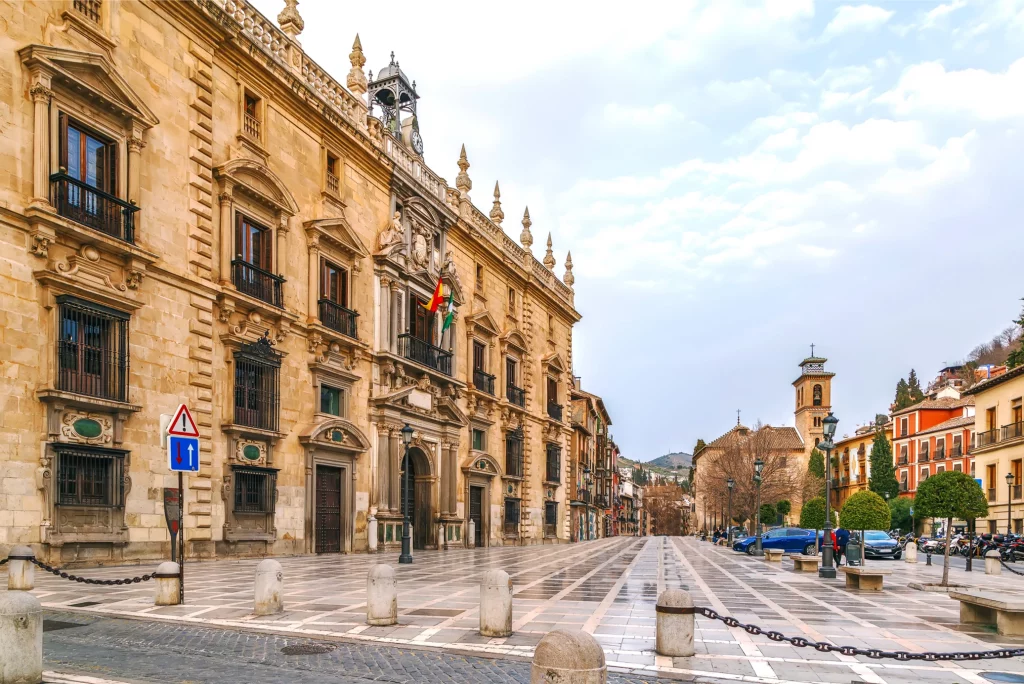
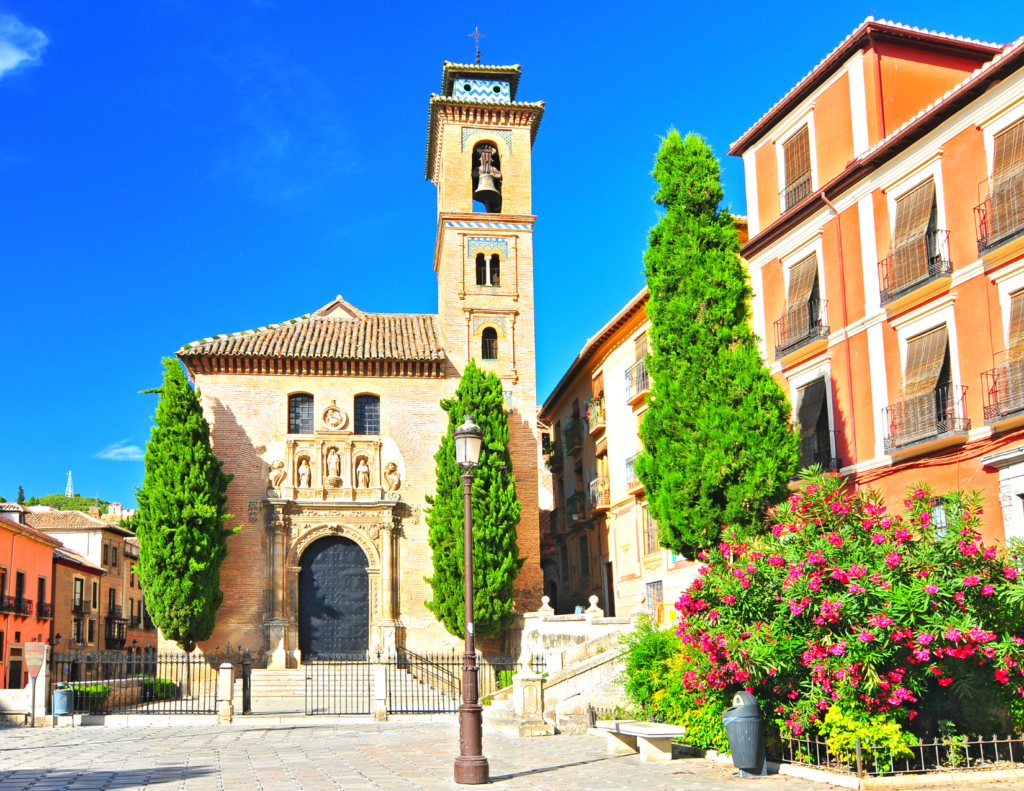
Slightly further away, you’ll find the Church of Santa Ana, located on a part of the square called Plaza de Santa Ana. To the right of the church is the fountain called Pilar del Toro, installed in 1941. The center of the fountain has a bull on it with two young boys either side.
A popular spot for tapas on Plaza Nueva is Los Diamantes. Unlike the more traditional Granada eateries, this restaurant is crisp and modern.
Plaza Nueva is the best place in Granada to catch a cab. It’s also where the tourist office is located. You’ll also have a peak at the Alhambra’s Alcazaba.
Not far from Plaza Nueva are Granada’s best shopping area, the best food market (Mercado San Augustin), and the Alcaiceria bazaar.
10. Take in a Flamenco Show
A classic thing to do in Granada is go to a flamenco Show. My Sacromonte tour guide said that Sacromonte is the best place to take in a flamenco show.
The gypsies brought a distinctive type of flamenco called Zambra. Zambra is a passionate flamenco dance and singing party with barefoot dancers and handheld castenets.
Flamenco is staged nightly on the main drag, Camino del Sacromonte. You can take in a show at Venta el Gallo, Maria la Canastera, or Cuevas Los Tarentos. Sacromonte’s most famous singer is Estrella Morente.
Click here to book a 1 hour show in one of Sacromonte’s caves.
11. Monasterio de San Jerónimo
Architect and history geeks can take in the underrated and obscure 16th century Monasterio de San Jerónimo. It’s one of Granada’s most impressive Catholic buildings.
It was the first monastery built after the Reconquista. Construction of the Gothic-Renaissance monastery began in 1496.
The patio courtyard is stunning, awash with orange trees. It has with 36 arches bearing shields of famous kings. The monastery’s main attraction is its intricate Baroque sacristy.
Tip: To get there, take Bus # 25 to the Cran Capitan stop.
12. Browse at the Alcaiceria Market
Granada boasts an exotic, Moroccan-style bazaar known as the Alcaiceria Market. It’s a must-visit attraction located just off the square near the Granada Cathedral.
As you explore the city center, you’re likely to come across it. Here, vendors offer a variety of goods like leather, ceramics, spices, glass ornaments, and silks. Be ready to haggle, though, as prices are often marked up for tourists.
I’m not a fan of negotiating myself (not great for a lawyer, I know), so I didn’t buy any trinkets. Nonetheless, the Alcaiceria is a fantastic place for photography enthusiasts, thanks to its vibrant colors and lively atmosphere.
Keep in mind, the market can be quite touristy. You might encounter women offering rosemary, claiming they’ll read your fortune, but it’s a common scam.
They’ll try to hand you rosemary and then ask for money. It’s best to politely ignore them and continue exploring.
13. Realejo Neighborhood
Another thing to do is explore Granada’s vibrant old Jewish quarter, known as the Realejo. This neighborhood, traditionally inhabited by ‘greñúos’ – a term referring to the residents’ characteristic dark curly hair – is perfect for leisurely strolls, much like the Albaicín.
As you wander, keep an eye out for the striking street art by Raul Ruiz, also known as “El Niño.”
Make a stop at the Plaza del Campo del Principe, a bustling square at the heart of Realejo. It’s a great spot for tapas or a drink. For a bite to eat, try Papua or Cacho e Pepe.
Don’t miss the Church of Santo Domingo, a beautiful sight both inside and out. The neighborhood is also famous for its grand mansions and lovely walled gardens, adding to its charm.
14. Frederico García Lorca House-Museum
If you’re a literature enthusiast, don’t miss the museum house of Spain’s greatest poet, Federico García Lorca, born in Granada.
Lorca’s life and work were deeply intertwined with the city, as he captured its essence in his poems and plays. His most famous work, “Romancero Gitano,” is a collection of poetry inspired by the romantic world of Andalusian gypsies.
Lorca’s former home, about 9 miles west of Granada, has been transformed into a museum. Nestled in a beautiful park, it’s a place of mythic significance for many. During a 45-minute guided tour, you’ll encounter original artifacts including drawings, paintings, and manuscripts.
The museum also sheds light on Lorca’s relationship with Salvador Dalí, the renowned Surrealist painter, hinting at a possible secret love story between these two Spanish artistic giants.
15. Hammam Al Andalus
After exploring the city, unwind in a traditional Arab bathhouse. Hamman Al Andalus, dating back to the 13th century, is conveniently located near Plaza Nueva, just below the Alhambra palace.
These bathhouses, once banned by the Catholic Kings, are experiencing a revival. While the modern Hamman Al Andalus doesn’t use the original Moorish structures, it stands on the same historic site used in medieval times.
Inside, you’ll find seven pools with varying temperatures, allowing you to switch between warm and cold baths. You can also add an aromatherapy massage to your experience.
For a truly authentic experience, opt for the full Kessa treatment, similar to a Moroccan Hammam. This includes an exfoliating treatment and Kessa soap, offering a luxurious experience, though it means slightly less time in the baths.
Click here to book your experience at the Hamman.
I hope you’ve enjoyed my guide to the best things to do and see in Granada. You may enjoy these other Spain travel guides and resources:
- Six 1 Week Itineraries for Spain
- 10 Day Road Trip From Madrid To Seville
- 10 Day Itinerary for Basque Spain
- 10 Day Itinerary From Barcelona to Bilbao
- 3 Day Itinerary for Barcelona
- 40+ Landmarks in Barcelona
- 2 Day Itinerary for Madrid
- Famous Landmarks in Spain
- 3 Day Itinerary for Seville
- Best Things To Do in Seville
- 2 Day Itinerary for Bilbao
Pin it for later.

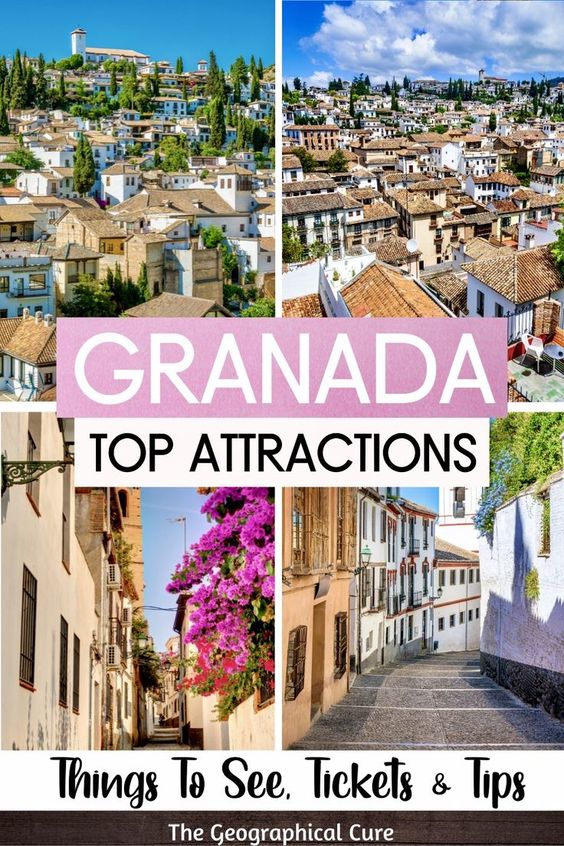
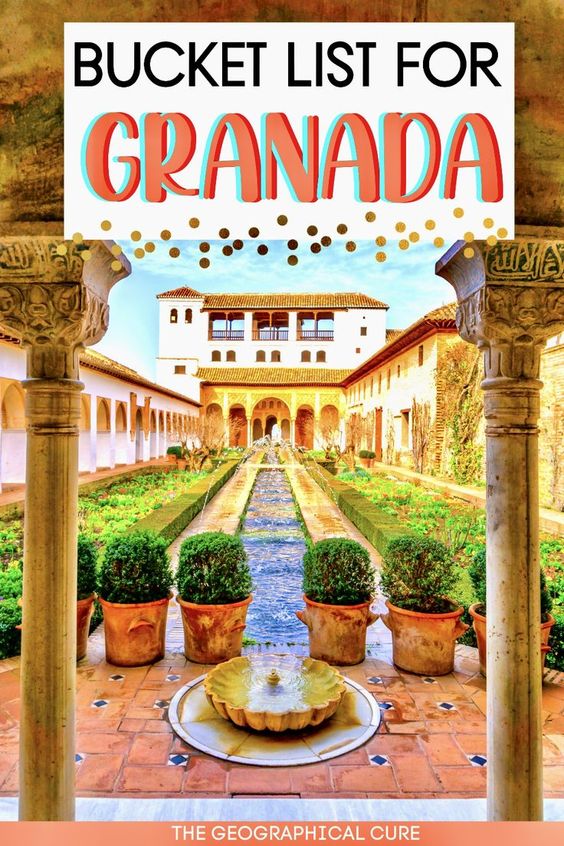
Hi Leslie, fantastic info again. Thanks for your blog. Can’t wait to start my trip.
I have a question. I was wondering if you know of any Flamenco places in either Seville, Granada or Cordoba where you can join in a Sevilliana?
I used to dance Flamenco for about 7 years but haven’t dance for an equal amount (doing Cuban Salsa now) but would love to do a workshop or go to a place where they allow you to join in dancing.
Might be a long shot but I thought I ask:-)
Thanks
Nadja
Hi Leslie, I actually found some places in Sevilla that offer courses and workshops:-)